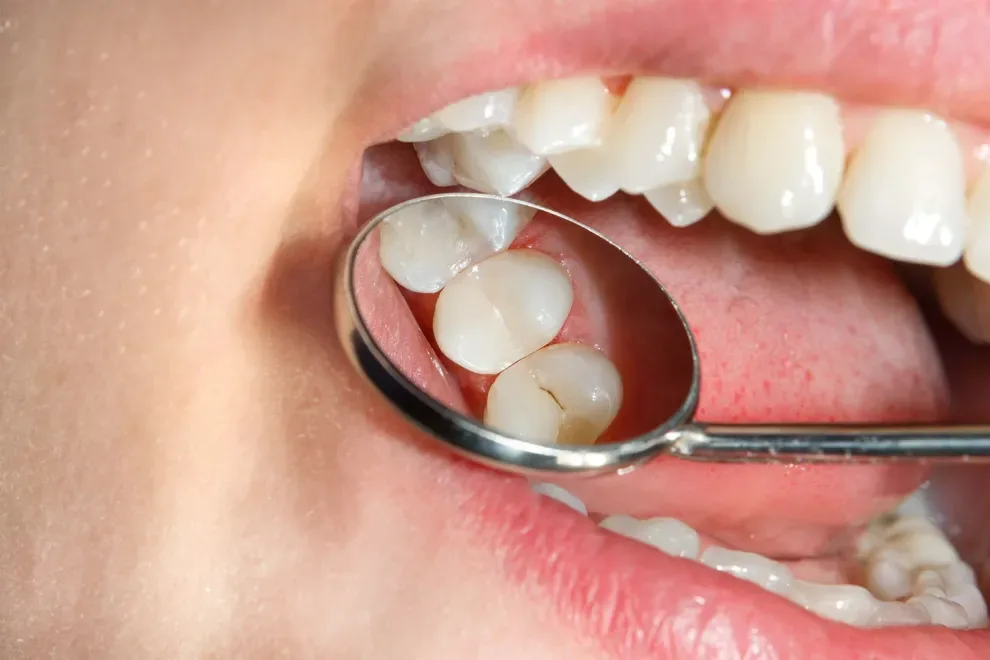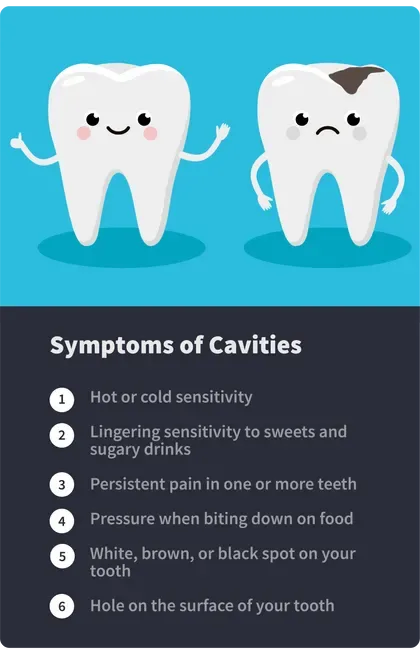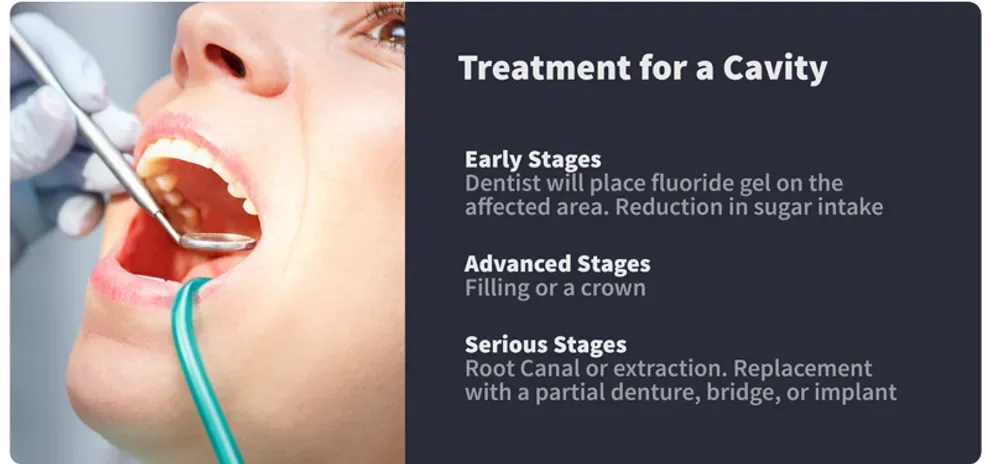Guide to Cavities: Causes, Symptoms & Treatment Options

Table of Contents
- Causes
- Fluoride, Saliva & Old Fixtures
- How to Prevent Cavities
- Symptoms
- Pain & Stains
- Treatment
- References
A cavity is an area of one of your teeth that is permanently damaged. It develops into a tiny hole that can grow larger if left untreated.
Cavities (also known as tooth decay) are one of the most common health problems in the world, affecting people of every age, ethnic heritage, and socioeconomic status.
Cavities are caused by a number of different factors, but some people are more at risk for their development than others. Generally, bacteria in the mouth (plaque), lots of snacks and sugar (and sugary drinks), and poor dental hygiene are the conditions that help cavities form and grow.
Without treatment, cavities can grow to the point where they affect deeper layers of the teeth. This can cause a severe toothache and infection, even leading to the tooth falling out or having to be extracted to prevent more damage.
Regular visits to the dentist, twice-daily brushing, flossing, and cutting out problematic foods and drinks are the best ways to protect teeth against the development of cavities.
What Causes Cavities?

These are common causes of cavities:
Snacks & drinks high in sugar
Poor oral hygiene
Not seeing you dentist regularly for cleanings
Misaligned teeth
Insufficient amounts of fluoride
Dry mouth
Eating disorders
Smoking
Dental fixtures like crowns
One of the reasons cavities are so common is that there are many causes behind their development.
Snacks and drinks that are high in sugar content are plentiful sources of fuel for the plaque that lives in the mouth. Even non-sugary food, like chips, can trigger the formation of plaque that eventually causes cavities to grow. Not brushing your teeth often enough or not flossing enough also plays a role in cavities. Having good dental hygiene is what removes plaque before it has a chance to decay and cause cavities.
However, even regular brushing and flossing cannot remove all plaque, so getting regular cleanings from a dentist is a must. A dentist has equipment and methods that can clean the teeth on a much deeper level than what you can do at home. Additionally, a dentist can also find and treat oral problems before they have a chance to become too disruptive or expensive to treat.
Having misaligned teeth can also lead to cavities. Teeth that are harder to clean can foster plaque buildup, making them much more likely to decay than teeth that are easier to reach with a toothbrush. There are many solutions to correct misaligned teeth, thereby ensuring they get the cleaning they need to prevent cavity development.
Fluoride, Saliva & Old Fixtures
Not having enough fluoride is also a problem that can cause cavities. Fluoride is a mineral that protects against dental decay and also promotes good oral health. This is why it is included in many brands of toothpaste.
Certain health conditions contribute to tooth decay and cavities. People who have dry mouths will not have enough saliva to rinse off bacteria and plaque from the surfaces of their teeth.
Certain eating disorders can make stomach acids come up in the mouth, which weaken the enamel and hasten its decay. Smoking also has a similar effect on the teeth, as do some medications.
Old dental fixtures, like fillings and crowns, can be problematic. Over time, they give plaque another place to grow, and they are not always easy to clean. Dental fixtures are meant to be replaced or removed after a set time to prevent this from happening.
Many people believe that children are the only ones that get cavities, but as you age, changes in your mouth make them an adult problem too.
How to Prevent Cavities
Regardless of your age or dental history, there are steps you can take to prevent cavities and oral health problems.
Establishing and maintaining a good dental care routine is one of the most important steps you can take to prevent cavities. Taking care of your teeth and gums daily will ensure that plaque and food particles can’t build up to create inflammation and decay.
A good oral hygiene routine should include the following:
Brush twice daily. For those with braces, additional brushing between meals may be necessary. Just be sure to use a gentle toothbrush to avoid agitating the gums.
Floss once a day.
Use an antimicrobial mouthwash. Choose one without alcohol to avoid dry mouth.
Dental cleanings and exams are key to oral health. A proper cleaning performed by a dental hygienist will remove plaque buildup in places that are hard to reach.
Dental exams also allow the dentist and hygienist to identify any problems, including decay or gum issues, before they get worse and develop into serious issues like gum disease, cavities, or root issues.
For most people, routine dental checkups are scheduled every six months. For people with a higher risk of oral health problems, like the elderly or children with specific conditions, more frequent appointments may be needed.
Eating a wholesome and healthy diet can have a positive impact on your oral health. When trying to prevent cavities, consider eating these helpful foods:
Dairy: Cheese, milk, and yogurt are great for teeth because they’re rich in calcium, which aids in bone density, as well as casein, a protein that helps strengthen tooth enamel. Yogurt also has probiotics that help defend against bacteria and bad breath.
Celery and carrots: These crunchy veggies promote the production of saliva, which helps wash away bacteria.
Spinach and kale: Leafy greens are rich in calcium, folic acid, and gum-healthy vitamins and minerals.
Lettuce: Crunching on some hydrating and healthy lettuce is great for refreshing teeth during or after a meal.
If you’re experiencing any problems with your teeth or gums, talk to your dentist. Even if your symptoms only seem minor, like puffy gums or sensitivity, being proactive could help in catching the problem early on before it becomes a problem like a cavity.
Quitting smoking is one of the best things you can do for your oral (and overall) health. Smoking leads to decay and cavities, gum disease, and other oral health problems. Quitting smoking greatly reduces these risks, as well as the risk of oral cancer.
For resources on quitting smoking, visit smokefree.gov.
What Are the Symptoms of Cavities?

Symptoms of cavities include the following:
Hot and cold sensitivity
Lingering sensitivity to sweets and sugary drinks
Persistent pain in one or more teeth
Pressure when biting down on food
A white, brown, or black spot on your tooth
A hole on the surface of your tooth
There are a number of signs to alert you that a cavity has begun its formation or that a pre-existing cavity is getting bigger.
One of the most common signs that a cavity is in development is hot and cold sensitivity. Your affected tooth (or teeth) feels painfully sensitive after you have consumed something that is either hot or cold.
This is because as the cavity wears away the enamel of the tooth, it can also affect the hard tissue layer underneath the enamel, known as dentin. If dentin is too exposed, food or drink that is hot, cold, acidic, or sticky can stimulate the cells and nerves within a tooth. Feeling a sharp jab of heat or cold is usually the first sign of a cavity.
A very similar sign is if you experience a lingering sensitivity to sweets and sugary drinks. Processed sugars and not enough brushing and flossing wear down the enamel, exposing nerves in the teeth that are aggressively stimulated by more sweets and sugars. As with hot and cold foods, a sharp, lingering sensitivity to sugary products is another early warning sign of a cavity.
Pain & Stains
A persistent pain in one or more of your teeth can signal the presence of a cavity, even without the sensitivity of hot, cold, or sugary consumables. This kind of pain is an almost guaranteed indicator that you have a cavity.
The pain can have a very sudden onset, usually (but not always) immediately following eating or drinking. Some people experience a feeling of pressure when they bite down on food.
Cavities cause staining on the affected tooth, usually as a white spot that sometimes develops into a black or brown spot as the decay becomes more advanced. Looking at your teeth every morning for signs of discoloration can be a good way of detecting any spotting on your teeth.
The spot on the tooth is the start of the cavity, and as this worsens, it will develop into a hole on the surface of the tooth. It is usually noticeable when looking in a mirror or by running your tongue over the surface of the teeth. If the hole forms between the teeth, it might be difficult to see or feel with your tongue, but you will still feel pain and sensitivity if hot, cold, or sugary food passes over it.
If you notice any of these signs, schedule a dental appointment.
Treating a Cavity

Treatment for a cavity depends on its severity. It may include any of the following approaches:
Early stages: If the cavity is in its early stages, a dentist will apply fluoride gel on the affected area, to strengthen the enamel and boost the tooth’s resistance to acids in the plaque that grow cavities. The dentist will also talk to you about reducing your sugar intake as well as how often you brush and floss.
Advanced stages: In more advanced cases of decay, the dentist might use a filling or a crown, which involves removing the cavity and filling the resultant hole after administering local anesthesia.
Serious stages: In serious cases of cavities, where the decay has reached the center of the tooth (the pulp, containing blood and nerves), the tooth and its root will have to be removed, a procedure known as a root canal.The most serious stage of tooth decay is where the tooth is damaged to the point where it cannot be repaired or restored. Instead, a dentist will replace it with a partial denture, a bridge, or an implant.
